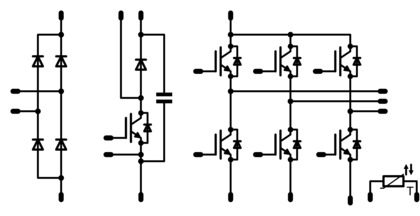PIM+PFC (CIP)

Structure
A CIP module has three functional blocks, a converter, an inverter and an active PFC. The converter is a rectifier with four or six diodes. Usually, diodes with 800 V or 1600 V blocking voltage are used to this end. The inverter consists of six IGBTs and six free-wheeling diodes. The types vary according to the given voltage: 600 V types are used for 230 V applications and 1200 V types for 400 V applications. Active PFC is comprised of a switching regulator operating at a high switching frequency, being able to generate a theoretical power factor of over 95%. Nearly all modules are equipped with an NTC or PTC alongside the power semiconductors.
Application
Power modules with CIP topology are most commonly used for grid-connected motor drive and embedded drive applications.
How it works
The rectifier converts the alternating voltage from the mains into DC voltage. A capacitor in an intermediate circuit smooth’s out the pulsating DC voltage so the inverter can convert it into a variable voltage with variable frequency, which then serves to adjust electric motors' speed and torque.
Active Power Factor Correction automatically corrects for AC input voltage in order to maximize the real power available from the mains, and is capable of a wide range of input voltage.
The simplest way of controlling the six IGBTs is to use pulse width modulation. The switching frequency often varies from 4 kHz to 12 kHz. It can range up to 16 kHz in some cases, but switching frequencies above 16 kHz are very rare. If too much energy feeds back into the intermediate circuit—for example, because the motor is braking hard—this voltage can be limited by the chopper IGBT and an additional resistor.
To learn more and see the full range of products, follow this link: PIM+PFC (CIP)

